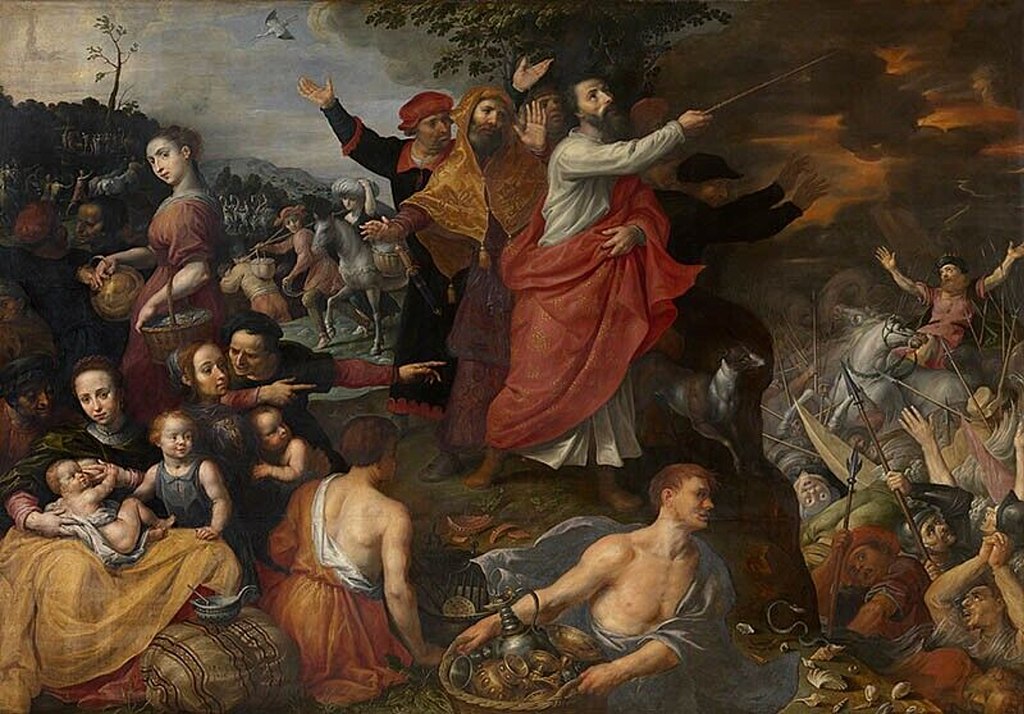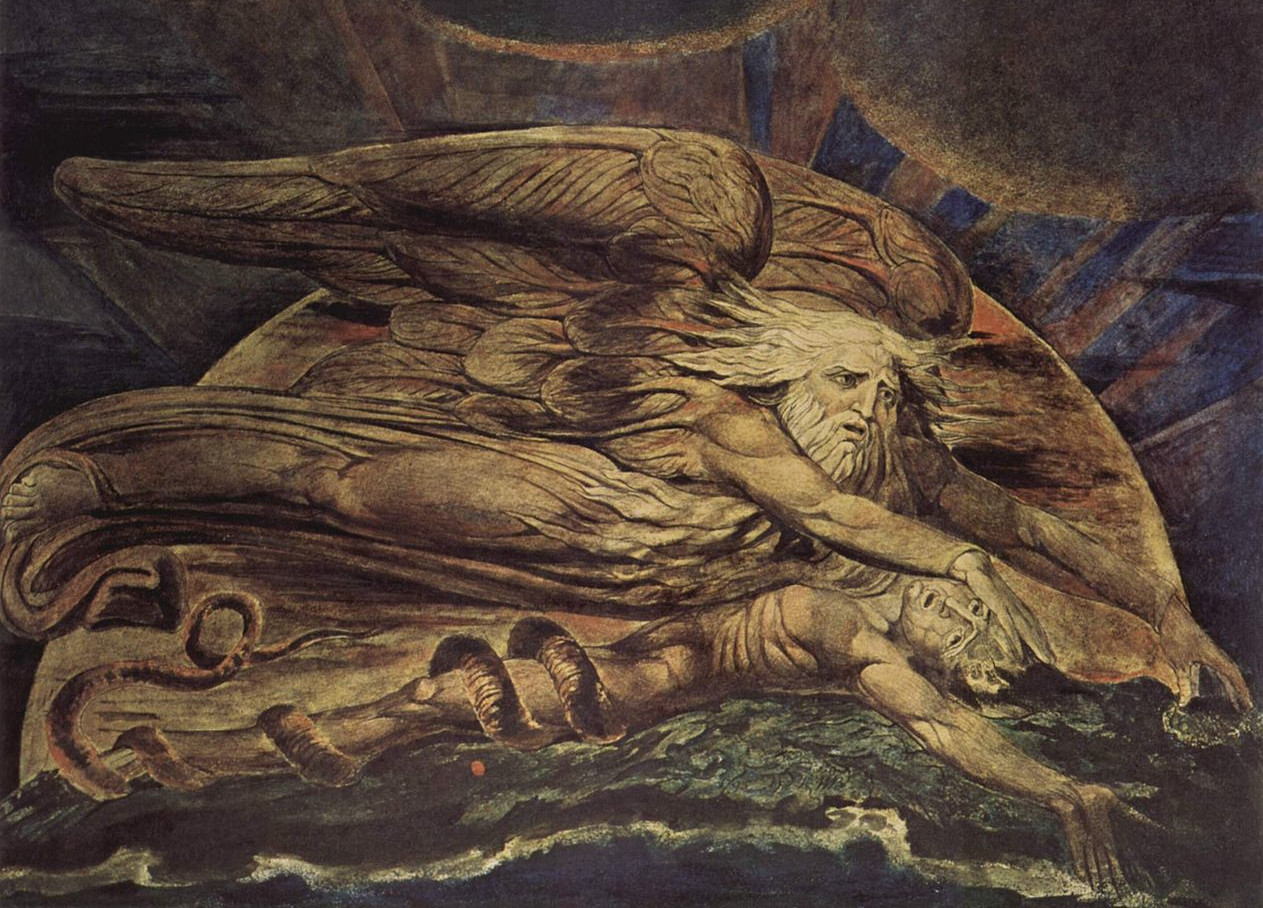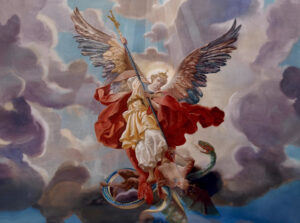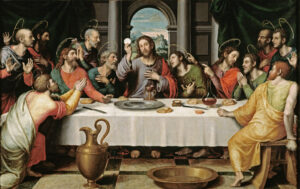Featured image: Elohim creating Adam. William Blake, Public domain, via Wikimedia Commons.
Key Takeaways
- Christian myths are profound narratives that convey timeless spiritual truths through symbolism and storytelling.
- Myths serve as bridges between the past and present, adapting to modern contexts while preserving their core messages.
- They shape personal faith, communal identity, and ethical frameworks within Christianity.
- Myths face challenges from secular criticism and internal debates but remain resilient and adaptable.
- Through creative expressions and cultural dialogue, myths continue to inspire and guide believers in the modern world.
The term “myth” often sparks different reactions, especially when mentioned in connection with religion. In casual usage, many associate myth with something fabricated or untrue. However, myth—understood in its deeper cultural, literary, and symbolic sense—can be a narrative that conveys enduring truths. In the context of Christian traditions, these stories function as vehicles for exploring universal questions, guiding moral reflection, and shaping collective identity.
From the earliest centuries of Christianity, mythic motifs and archetypes have informed core accounts: the Creation narratives in Genesis, the dramatic story of Jesus’s life and resurrection, and the visionary symbols found in apocalyptic literature. These elements address struggles between hope and despair, good and evil, and humanity’s search for redemption. While Christian traditions draw much of their strength from historical events, the mythic dimension goes beyond straightforward fact to evoke deeper questions of meaning and purpose.
Modern contexts introduce new questions about how myths function. Scientific advancements, interpretive scholarship, and diverse cultural perspectives prompt discussions about whether myths remain relevant or should be interpreted differently. How do modern believers reconcile poetic symbols with historical beliefs? Are these stories vestiges of a past worldview, or do they still offer insight in contemporary society?
This article examines such questions by outlining the many ways myth operates in modern Christianity. It highlights how myth informs spiritual formation, communal life, cultural expression, and moral frameworks. By recognizing the depth and adaptability of myth, readers can appreciate its continued significance for understanding identity, belief, and the broader human condition.
Table of Contents
Defining Myth in Christianity
Scholarly Conceptions
In scholarly usage, “myth” is not simply a falsehood or fairy tale. Rather, it is a story that uses symbolic language and archetypal imagery to communicate ideas about existence, the divine, and morality. Across various cultural traditions, myths forge connections between the temporal and the transcendent, inviting deeper reflection than bare literal descriptions often provide.
In Christianity, the word “myth” can be controversial because many believers associate it with fictitious claims. Yet theologians and literary scholars often employ “myth” in a constructive sense, referring to narratives that convey fundamental truths through storytelling. This understanding emphasizes the power of symbolism to speak to questions beyond the scope of empirical evidence.
Cultural Function of Myth
Myths serve as cultural touchstones that unite communities under shared narratives. They provide a framework for understanding life’s mysteries—where we come from, why suffering exists, and where hope might be found. In Christian contexts, mythic components appear in doctrines, liturgies, visual art, and communal traditions, each offering a lens into profound truths about God, creation, redemption, and human responsibility.
Some interpret the biblical stories of Adam and Eve, the flood, or the resurrection of Jesus in a literal-historical manner, while others read them symbolically. Regardless of interpretive stance, these stories shape how believers conceive of morality, human nature, and the divine, thereby performing a vital function in faith communities.
Historical Roots and Early Interpretations
Cultural Interactions in Early Christianity
Early Christian communities were not isolated from the broader cultural worlds around them. They inherited narratives from Jewish scriptures—tales of creation, exodus, covenant—which carried mythic depth. Simultaneously, they encountered Greco-Roman contexts where epic tales and hero myths were central to cultural life.
Elements such as the heroic quest, cosmic conflict, and divine-human interplay found parallels in Christian interpretations of Jesus’s life, death, and resurrection. Early theologians like Justin Martyr noted the presence of mythic themes in non-Christian sources yet insisted on the unique claims of Christian faith.
Myth as Theological Expression
Myth allowed the earliest believers to explain mysteries surrounding God’s nature, the Incarnation, and the Trinity in language that resonated with symbolic significance. For instance, the Prologue to the Gospel of John describes Christ as the “Word” (Logos) who was present at creation, weaving a cosmic dimension into the story of Jesus’s ministry.
Such passages blend historical references with metaphysical allusions, merging time-bound events with timeless truth. This blending has fueled centuries of theological reflection, showing how mythic elements can amplify the spiritual core of Christian messages.
Scriptural Canon and Mythic Influences
As the Christian canon solidified over the first few centuries, certain texts—including the Book of Revelation—demonstrated an unmistakable mythic character. Symbolic beasts, cosmic battles, and visions of a transformed world populated John’s apocalyptic writings, connecting Christian theology with dramatic imagery found in prophetic and ancient Near Eastern literature.
Early interpreters approached Revelation in diverse ways: some saw it as a literal prophecy of future events, while others read it as a symbolic reflection on the struggle between good and evil. These varied readings illustrate how mythical language permeated the scriptural canon and remained open to multiple layers of meaning.

Mythical Elements in Biblical Narratives
Creation and the Human Condition
Biblical accounts in Genesis depict creation in majestic terms: God speaks the universe into existence, shaping the cosmos in stages. The portrayal of Adam and Eve in the Garden of Eden includes talking serpents, symbolic trees, and a moral drama that explains the emergence of sin.
These elements, rich in mythic content, direct attention to profound questions: Where do human beings fit in the cosmic order? Why does suffering exist? What is the nature of free will and responsibility? Whether one interprets this story literally or metaphorically, its themes continue to resonate, framing ongoing debates about human origins and moral accountability.
The Heroic and Sacrificial Themes
The life of Jesus as depicted in the Gospels can also be viewed through mythic archetypes. He is portrayed as a figure who embodies the hero’s journey, displaying miraculous authority over nature, confronting spiritual adversaries, and ultimately laying down his life for the sake of humanity. In this narrative, the Crucifixion and Resurrection bear similarities to myths of dying-and-rising deities, though Christian tradition insists upon the unique historical reality of these events.
Despite differences in emphasis—historical fact vs. symbolic pattern—the heroic and sacrificial dimensions of the Gospels have functioned as timeless sources of inspiration. Artistic depictions of Christ’s Passion and homiletic reflections on self-sacrifice in Christian worship highlight these mythic layers.
Apocalyptic Imagery
Apocalyptic sections of the New Testament, especially in Revelation, showcase mythic imagery in stark detail: dragons, sealed scrolls, bowls of wrath, and symbolic beasts. Each figure communicates conflicts that stand for ultimate moral or spiritual battles. Historically, these images have been read in multiple ways: as coded critiques of political power in ancient Rome, allegories about final judgment, or symbols of divine justice triumphing over chaos.
The result is a narrative that invites readers to look beyond immediate circumstances, anticipating a renewed creation. Whether understood literally or figuratively, apocalyptic myths remain embedded in Christian imagination, fueling speculations about the end times and offering hope in the face of suffering.
Modern Shifts in Interpretation
Critical Scholarship and Historical Methods
Beginning in the 17th and 18th centuries, thinkers began to examine biblical texts through emerging scientific and historical-critical methods. This approach placed emphasis on questions of authorship, context, and the layering of traditions within scripture. Stories that had been treated as literal were re-examined in light of archaeological findings and comparative mythology from ancient Mesopotamia, Egypt, and beyond.
The account of Noah’s flood, for instance, was compared with the Babylonian Epic of Gilgamesh. While parallels fueled debates about which narrative emerged first, the broader effect was to encourage symbolic interpretations of biblical myths rather than exclusively literal readings.
The Intersection with Science
The rise of evolutionary biology and geology during the 19th century prompted some theologians to reconsider how to interpret the creation narratives in Genesis. The six-day timeline appeared inconsistent with the immense age of the universe and the gradual development of life on Earth.
In response, many scholars embraced the idea that biblical myths served a different purpose than scientific explanations. The creation story became a way to affirm humanity’s moral and spiritual bond with the Creator, addressing questions of purpose and accountability rather than providing a cosmological blueprint.
Myth and Modern Theology
By the 20th century, influential theologians such as Rudolf Bultmann argued for the “demythologizing” of Christian texts. This did not necessarily mean dismissing myth but rather discerning the existential truths within mythic language. Bultmann suggested that mythic stories should be reinterpreted to uncover their inner messages about faith, guilt, redemption, and authentic existence.
These scholarly trends gave believers fresh tools for reconciling Christian doctrines with modern knowledge. The shift encouraged viewing mythic elements as metaphors and symbols, preserving their depth and moral power while avoiding direct clashes with scientific data.
Diverse Denominational Perspectives
Literalist Approaches
Within certain branches of Christianity—often categorized as fundamentalist or conservative evangelical—many insist on a literal reading of scripture. Here, mythic narratives are not simply symbolic; they are factual accounts of historical events. The creation in six days, the global flood, and the miracles of Jesus are all treated as literal occurrences that confirm the trustworthiness of the Bible.
These believers regard any retreat from literalism as undermining Christian authority. They point to passages where biblical authors treat earlier stories as genuine history, arguing that faith in God’s miraculous activity should extend to acceptance of biblical mythic narratives in their literal forms.
Symbolic and Allegorical Approaches
On the other side of the spectrum, mainline Protestant denominations and Roman Catholicism often interpret certain biblical myths with symbolic depth rather than factual literalism. While core historical claims (such as the existence of Jesus, his ministry, and his crucifixion) are generally maintained, narratives like the story of Jonah or apocalyptic visions may be treated as allegories teaching spiritual or moral truths.
This perspective allows for harmony between scripture and ongoing discoveries in science or history. For instance, seeing Adam and Eve as mythic prototypes of humanity’s moral struggles enables Christians to integrate evolutionary theory without discarding the theological implications of the narrative.
Liberation Theologies and Contextual Readings
In the 20th century, movements like liberation theology recontextualized biblical myths for social and ethical critique. The Exodus account, which tells of Israel’s deliverance from bondage, became a paradigm for analyzing modern forms of oppression. The story’s mythic status does not diminish its power as a model of divine justice and communal liberation.
These contextual interpretations highlight how myth’s function can shift based on cultural and societal needs. They see biblical narratives as calls to action, urging believers to confront injustice in their own contexts.

Myth’s Functions in Contemporary Christian Life
Formation of Identity
Christian myths create a collective sense of identity for believers. Through stories of creation, covenant, and redemption, communities recognize themselves as part of a divine story stretching across time. This sense of continuity is reinforced through rituals like the Eucharist or Baptism, which draw on mythic images—Christ as the sacrificial lamb, or the transformative passage through water—to underscore spiritual truths.
On an individual level, these myths can shape a person’s narrative of self-understanding: seeing oneself as part of a redeemed family, called to reflect virtues like love, humility, and compassion.
Ethical Guidance
Mythic stories in Christianity often involve moral dilemmas or archetypal conflicts between good and evil. Whether it is David facing Goliath, Jesus confronting temptation in the wilderness, or the Good Samaritan offering care to a stranger, these narratives teach principles of courage, compassion, and faithfulness.
Even when read symbolically, the lessons carry weight. Parables taught by Jesus, steeped in mythic resonance, supply moral frameworks that guide believers’ choices in modern society—helping them address social challenges, personal struggles, and spiritual development.
Communal Solidarity
Because myths are shared narratives, they fortify unity among Christians who rehearse them through worship, festivals, and church seasons. Major events such as Christmas or Easter recall mythic episodes from scripture—Christ’s birth or his resurrection—and invite communal participation in retelling these stories each year.
This cyclical retelling reinforces core beliefs, preserving the cultural and spiritual heritage of Christianity across generations. Even those who question certain theological aspects frequently find meaning in the communal practices surrounding these celebrated myths.
Personal Transformation
On a personal level, many believers find that immersing themselves in mythic narratives fosters spiritual growth. Stories of redemption, healing, and divine presence can inspire hope amid hardship. Mythic symbols—like light overcoming darkness—speak to inner struggles, encouraging believers to embrace renewal, forgiveness, and transformation in their own lives.
Some approaches to Christian spirituality employ contemplative methods that explore biblical images meditatively. By engaging with mythic motifs, practitioners invite personal encounters with themes of suffering, grace, and rebirth, applying ancient narratives to present-day challenges.
Challenges and Debates in Modern Contexts
Critiques from Non-Religious Viewpoints
In societies influenced by scientific research and rationalistic philosophies, myths can face criticism for appearing unverified by empirical data. Creation stories or global flood accounts may be dismissed as archaic when contrasted with modern disciplines like evolutionary biology, astronomy, or geology.
Additionally, some argue that clinging to mythic narratives in a literal sense can lead to intellectual conflict. Such critiques question whether these stories continue to hold any real authority in a time that values tangible evidence. However, others reply that myth does not attempt to serve the same function as science and that symbolic meanings address moral and existential inquiries beyond the realm of empirical analysis.
Internal Disputes
Within Christianity itself, debates over myth are often bound up with questions of biblical authority, hermeneutics, and denominational identity. Literalist interpreters worry that symbolic readings dilute key doctrines or open the door to unrestrained reinterpretation. Those favoring more symbolic viewpoints respond that rigid literalism risks overlooking the profound spiritual depths that mythic language can reveal.
This tension sometimes manifests in controversies over curriculum in religious education, church leadership qualifications, or ecumenical dialogue. Some communities prefer confessional statements that solidify literal readings, while others embrace broader theological breadth, granting myths freedom to function as narratives that transcend purely factual claims.
Moral and Ethical Questions
Certain biblical myths—especially involving conquest or divine judgment—raise ethical questions in modern settings. The conquest narratives in the Old Testament, for instance, describe warfare that can conflict with contemporary moral standards.
Readers who hold these texts as literal face challenges in reconciling them with values of peace and human rights. Symbolic interpreters might see these accounts as part of a mythic struggle against evil, inviting readers to wrestle with deeper lessons about human violence, divine justice, and forgiveness.
Renewed Significance: Myth in the 21st Century
Interest in Narrative and Storytelling
Even as rational critiques persist, the 21st century has also witnessed a growing cultural enthusiasm for storytelling—from novels and films to digital media. This broader interest in narrative underscores the lingering power of myth. In Christian contexts, stories of Jesus’s life, biblical heroes, and apocalyptic visions continue to inspire new adaptations and retellings.
Younger generations, often drawn to imaginative worlds in fantasy literature and interactive gaming, can find resonance with mythic aspects of Christianity that emphasize epic battles, transformative quests, and ultimate hope.
Cross-Disciplinary Dialogue
Scholars from fields like anthropology, psychology, and literary studies contribute to the conversation by highlighting the psychological and sociological roles of myth. Concepts from Carl Jung or Joseph Campbell, for instance, describe universal archetypes that appear across cultures. Christian myths, by this reckoning, tap into shared human patterns of meaning-making.
This cross-pollination of perspectives allows modern believers to see myth as part of a broader tapestry of human spiritual expression, bridging gaps between ancient tradition and contemporary intellectual currents.
Myth in Popular Media
Modern films, novels, and series often incorporate mythic layers drawn from Christian themes. Works like The Chronicles of Narnia, inspired by C. S. Lewis, integrate Christian allegory with fantasy, presenting Christ-like figures and redemption themes in accessible narratives. Similarly, creative retellings of biblical stories—like animated films on Exodus or dramatizations of the Nativity—showcase how myth transcends time and culture.
Such endeavors can bring Christian mythic elements to audiences that might otherwise have limited exposure to scripture, reminding viewers and readers that these foundational stories can speak to contemporary concerns about loyalty, betrayal, sacrifice, and new beginnings.

Global Expressions and Intercultural Exchange
Adaptation in Non-Western Contexts
As Christianity continues to grow in Africa, Asia, and Latin America, biblical myths interact with local traditions, creating fresh expressions of faith. In many contexts, pre-existing myths about creation, spirits, or heroic ancestors blend with Christian accounts. This process can enhance rather than diminish the biblical stories, producing new layers of understanding.
For example, the depiction of Jesus as a healing shaman figure in certain African communities or the alignment of the nativity story with local childbirth customs highlights how universal mythic archetypes (like birth under humble conditions or cosmic significance) can adapt to varied cultural environments.
Interfaith Considerations
In interfaith dialogues, Christian myths often encounter narratives from other major religions. Parallels in creation myths, flood stories, or hero archetypes reveal points of commonality. This can lead to mutual appreciation for shared motifs, though it also raises questions about the distinctiveness of Christian claims.
Some theologians welcome these conversations, seeing them as opportunities to illustrate how myths from multiple traditions converge on core human dilemmas. Others emphasize that Christian myths, while sharing universal elements, ultimately refer to a specific understanding of salvation in Jesus Christ—maintaining a balance between universal archetypes and unique doctrinal tenets.
Preservation and Innovation
Global Christianity has the capacity to honor traditional readings of myth while encouraging innovative interpretations that speak to present needs. Community leaders can leverage biblical myths to address social issues, create empathy for marginalized groups, and encourage responsible stewardship of natural resources.
In many parts of the world, environmental movements draw on the Eden narrative to promote harmony between humanity and the environment. The mythical depiction of a garden created “good” resonates with those seeking spiritual motivation for ecological responsibility.
Creative Adaptations: Art, Literature, and Media
Artistic Expressions
From the medieval period’s stained-glass windows depicting biblical scenes to contemporary murals in urban churches, Christian myths have consistently inspired art. Scenes of Creation, the Fall, the Crucifixion, and the Resurrection appear in countless forms, each capturing mythic depth through visual symbolism.
Modern artists sometimes subvert or reinvent these images to critique institutional power or highlight neglected dimensions of the tradition. These reinterpretations can stimulate new appreciation for myth’s complexity and spark dialogue around faith, justice, and cultural transformation.
Literary and Theatrical Renditions
Literary works—ranging from Dante’s Divine Comedy to modern poetry—interweave Christian myths with imaginative detail. Playwrights stage Passion plays or Christmas pageants, retelling core biblical narratives for local communities. These performances foster a living connection to the mythic past, offering worshipers a tangible way to engage with stories that have shaped their worldview.
In novels and short stories, writers may allude to Christian myths to explore redemption, human frailty, and resilience. The references need not be overtly religious; mythic echoes in characters or plotlines can evoke Christian themes in subtle yet powerful ways.
Digital Media and Mythic Storytelling
In the 21st century, digital platforms—from online sermons to social media campaigns—allow Christian communities to present mythic stories in fresh formats. Videos or animations can recount biblical episodes with modern graphics, while podcasts facilitate extended discussions about how these myths relate to current events.
Additionally, Christian video games sometimes frame moral choices and fantasy quests within a mythic architecture that borrows from biblical images. Although such adaptations vary in quality and depth, they represent a renewed interest in presenting ancient stories in accessible formats to tech-savvy audiences.
Conclusion
Enduring Power of Myth
Christianity’s mythic dimension has endured for centuries, shaping art, communal rituals, ethics, and personal faith. Far from being mere fabrications, these narratives offer frameworks through which believers address questions of origin, destiny, suffering, and hope. Myths bridge the concrete and the transcendent, merging historical claims about Jesus and the early church with timeless archetypes that speak to universal human longings.
While debates about factual versus symbolic readings continue, the flexibility of myth ensures its relevance in many spheres. Literalists find in these narratives proof of divine action in history, while more symbolically inclined interpreters see a wellspring of archetypal imagery that reveals spiritual truth. Across denominational lines, there is a shared recognition that these stories convey meaning exceeding what straightforward data alone can impart.
Challenges and Opportunities
The modern era presents challenges—ranging from scientific scrutiny to internal disputes over scriptural authority. Yet these very challenges can encourage Christians to reexamine the deeper purposes of myth. Whether exploring cosmic beginnings or apocalyptic endings, the core insights remain potent: humanity’s moral freedom, the possibility of redemption, and a worldview that imbues existence with transcendent value.
Critics who dismiss myth as obsolete may overlook how it works on a plane different from empirical verification. Myths can illuminate moral and existential realities that statistics cannot quantify. Their interpretive flexibility allows them to adapt to changing cultural and intellectual climates, exemplifying how enduring stories can remain vital.
Future Directions
Looking ahead, the role of myth in modern Christianity may grow even more pronounced as communities seek expressions of faith that speak to diverse cultures and urgent global issues. Environmental concerns, social justice movements, and interfaith conversations all stand to benefit from the integrative power of mythic storytelling.
In a pluralistic era, Christian myths also serve as dialogue partners with other religious narratives. Comparative mythologists, theologians, and lay believers can find new ways to appreciate both the uniqueness of biblical stories and their resonance with broader human themes.
Final Reflections
Myths in Christianity hold enduring significance: they are not casual fabrications but potent narratives that carry believers through life’s complexities. They offer hope, shape collective identity, and serve as anchors for theological convictions. In worship, art, scholarship, and daily practice, myth remains a dynamic force—both a link to the ancient heritage of the faith and a source of new insights for the 21st century.
By recognizing the symbolic richness and adaptability of these stories, modern Christians—and society at large—can continue drawing meaning from them. Whether viewed through literal lenses or embraced for their metaphorical depth, Christian myths invite reflection on fundamental questions about what it means to be human, to face suffering, to yearn for redemption, and to dwell in community with others seeking hope. They stand as enduring testaments to humanity’s pursuit of purpose and connection with something greater, ensuring that these tales retain their transformative potential far into the future.



